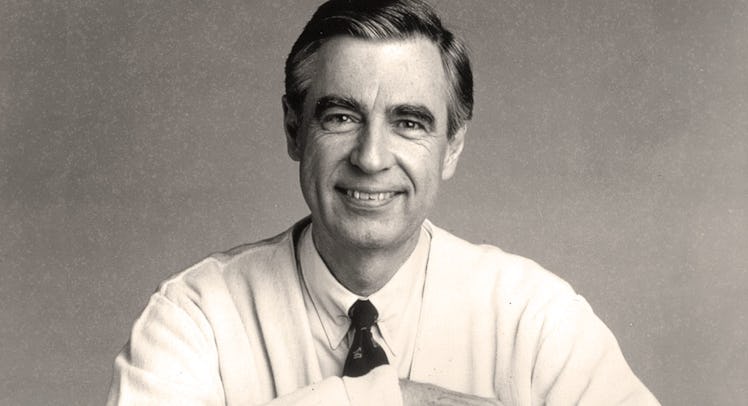Watching the First Episode of ‘Mister Rogers’ Neighborhood’ on its 50th Anniversary
Five decades after the first episode of Fred Rogers' show, it feels more audacious and stranger than ever.

The first episode of Mister Rogers’ Neighborhood, which aired on February 19, 1968, opens with pan over a quiet neighborhood of featureless dollhouses and tenement-style apartment blocks set in neat, suburban yards. It’s an attractive neighborhood — not wealthy, not poor — that pairs nicely with the bubbling, Lawrence Welkian theme. The credits stop rolling after 30 seconds and the camera fades into Mister Rogers’ house as he arrives, all limbs and smiles. Then he makes a statement of intent in the form of a remarkably slow two minute and thirty five second tracking shot.
To watch the first scene in the first broadcast of Mister Rogers’ Neighborhood is to be reminded of both Fred Rogers’ auteurist conviction and his remarkable ability to stick a landing. Some 50 years later, it is also a reminder that his long-term charm offensive wasn’t enough to hold all the Paw Patrols and Spongebobs of the world at bay. The clip feels less old than it does totally alien.
The song and the ritualistic shoe-change are slow. These are, by the standards of modern media executives, bad television. Attention is not captured; it is politely requested. The complex motivations of this Mister Rogers character are left unexplored. There is absolutely no exposition and no foreshadowing. There is just a man of indeterminate age — he was 29 — smiling broadly. “A ladder is something that helps you go up…” he explains, “and down.”
There is no trick. There is just this man. Even accepting that feels deeply emotional. It has become, after all these years, alienating to not be manipulated.
Think, for a second, what that says about the man. Think about Fred Rogers, who wrote the song and the words, telling the cameraman to just stay on him. Think of the self-confidence required to make that request and also of the selflessness required to use that moment to talk about how hard it is to tie shoes. In a large part, it was this unwieldy, borderline paradoxical combination of traits that ultimately made Rogers such an important cultural figure. But it wasn’t just that. It was that Fred Rogers was determined to be an important cultural figure. The besweatered saint of Latrobe, Pennsylvania didn’t bumble his way to stardom. He walked that way deliberately in comfortable shoes.
That two minute and thirty five second opening shot was Fred Rogers, disliker of violent, overwrought, and mean-spirited kids entertainment, stating firmly that he had a better way. What’s more, it was Fred Rogers, child development expert and savvy televisual communicator, proving it. Rogers was creating something to address the needs of his audience rather than the wants of his audience. He was optimizing for the well-being of children.
And that’s why those two minutes and thirty five seconds of footage is so jarring. It’s not that the footage feel dated — it’s still lovely and meditative — but that it isn’t engineered to release endorphins, trigger a behavior, or hook the audience in any way. In an age of weaponized entertainment and algorithmic mass hypnosis, it feels wrong. It feels like it’s missing something. And it is. It’s missing cynicism.
Fred Rogers didn’t predict smartphones or social media, but he did see the men and women of the media industry grasping hungrily for eyeballs. And he saw the pain this cause. He knew that he could provide relief if Americans would accept it.
50 years later, time has made it clear that Fred Rogers was right about us, right about himself, and wrong to think that he could prevent or even stave off the inevitable. The generous, purposeful confidence of his mild-mannered performance has never been replicated. It’s likely that it never will. Creators lack either the confidence, the will, the conviction, or the opportunity.
Fred Rogers is remembered with fondness because he was a man who trusted us and gave us no reason not to trust him back — not ever. We think of Rogers as a titan, but, in February of 1968, only he knew that was inevitable. Watching that first show again, it’s clear that he did know. It’s clear that he had no doubt.
This article was originally published on